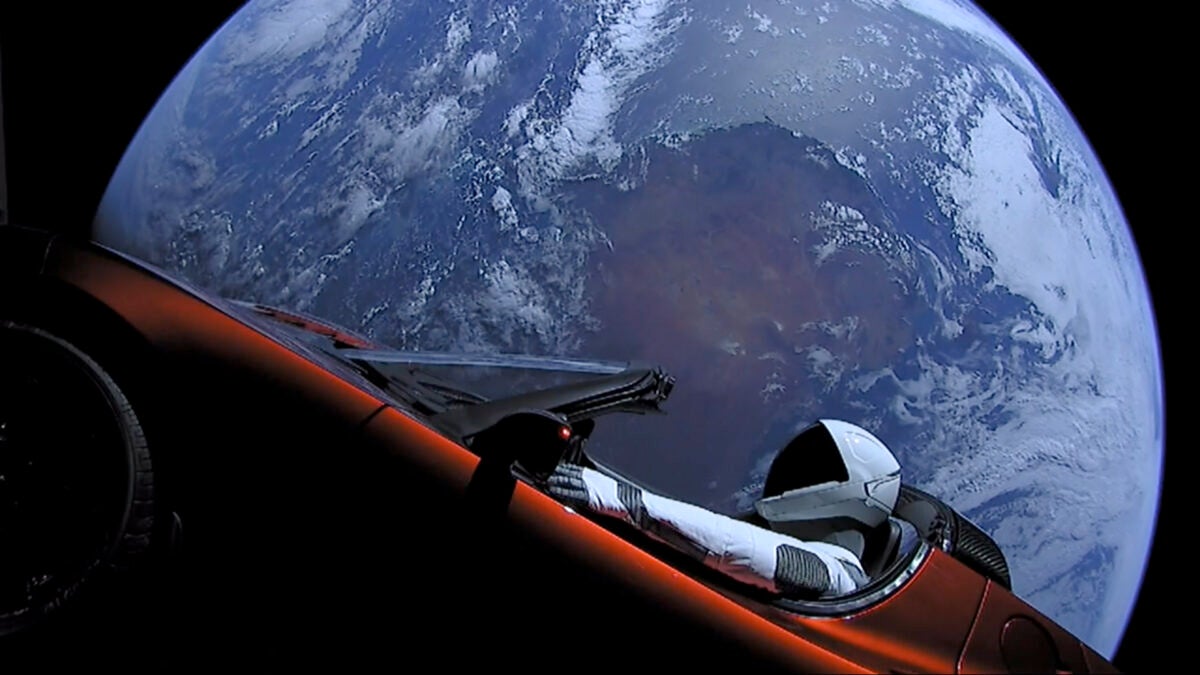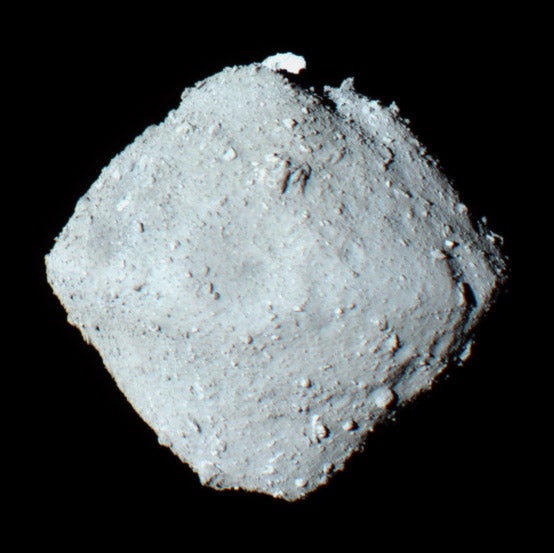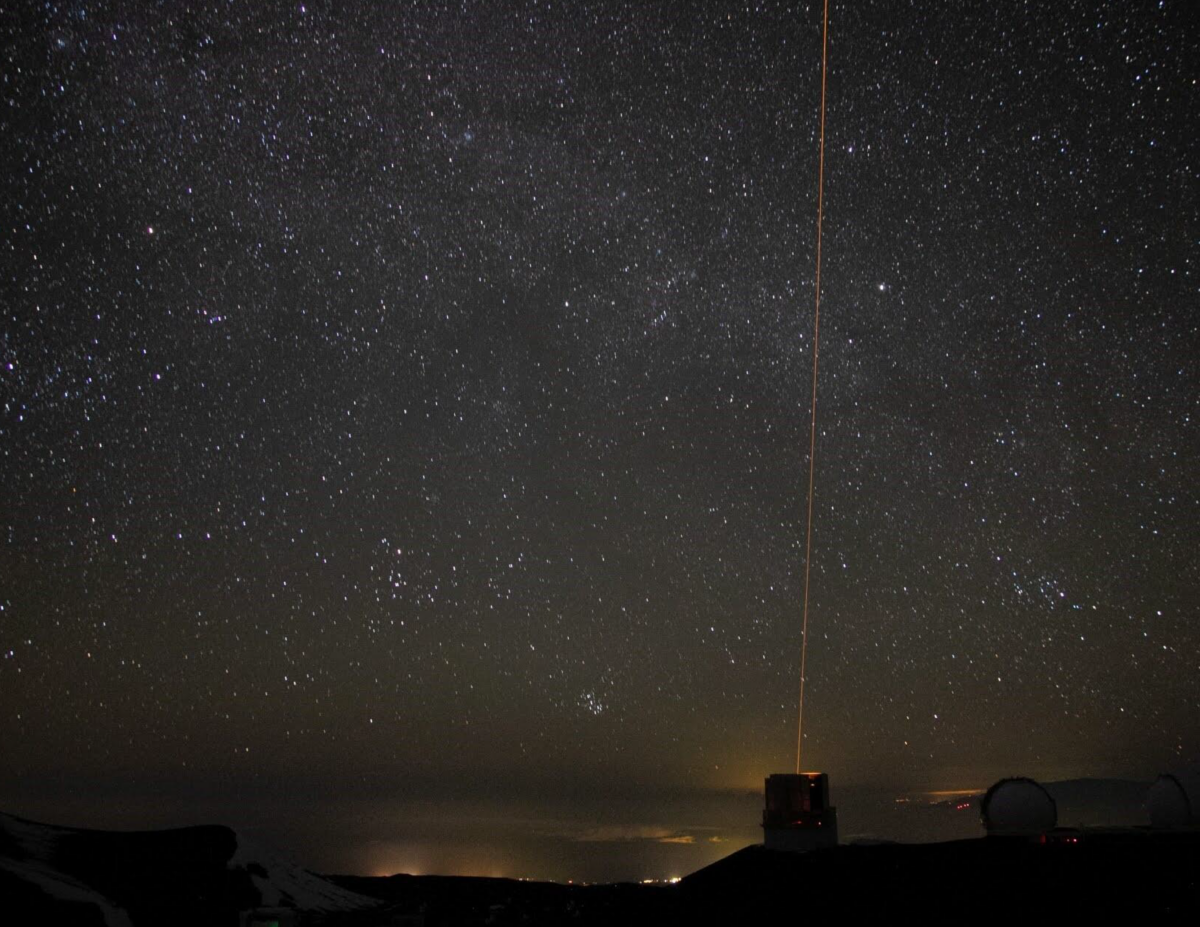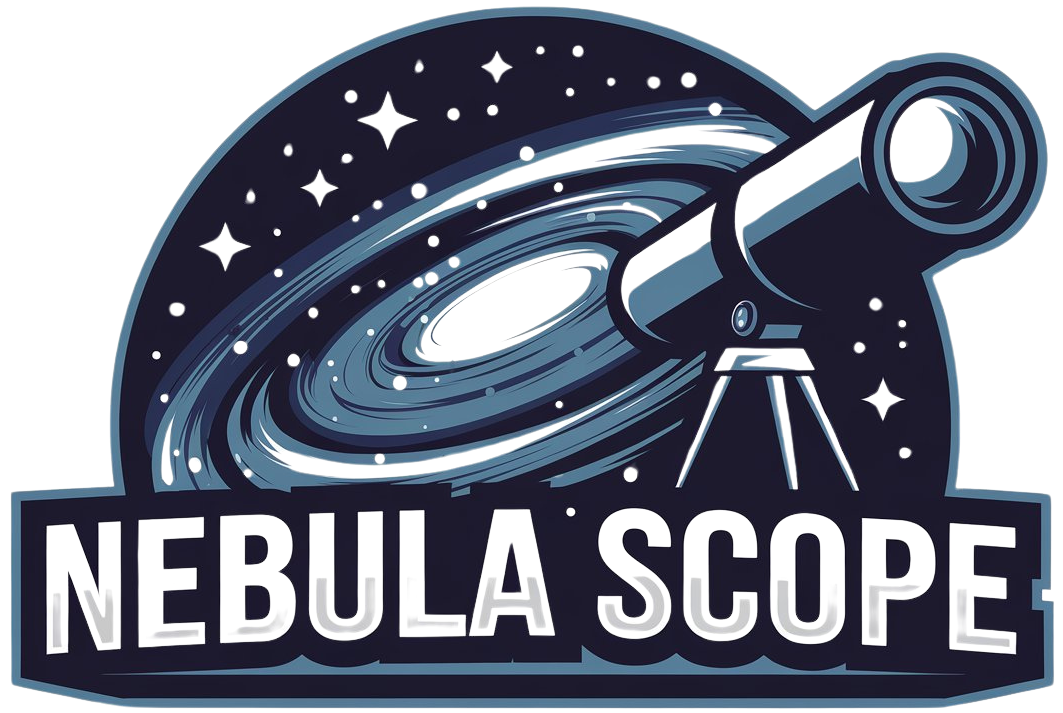That’s no asteroid. That’s … a automobile? Credit score: SpaceX
On Jan. 2, the Minor Planet Heart on the Harvard-Smithsonian Heart for Astrophysics in Cambridge, Massachusetts, introduced the invention of an ordinary asteroid, designated 2018 CN41. First known and submitted by way of citizen scientist H. A. Güler, the article’s orbit used to be notable: It got here not up to 150,000 miles (240,000 kilometers) from Earth, nearer than the orbit of the Moon. That certified it as a near-Earth object (NEO) — one value tracking for its possible to one day slam into Earth.
However not up to 17 hours later, the Minor Planet Heart (MPC) issued an article understand: It used to be deleting 2018 CN41 from its information as a result of, it became out, the article used to be now not an asteroid.
It used to be a automobile.
To be exact, it used to be Elon Musk’s Tesla Roadster fastened to a Falcon Heavy higher level, which boosted into orbit across the Solar on Feb. 6, 2018. The auto — which were owned and pushed by way of Musk — used to be a take a look at payload for the Falcon Heavy’s first flight. On the time, it won quite a lot of notoriety as the primary manufacturing automobile to be flung into area, whole with a suited-up model within the motive force’s seat named Starman.
The case of incorrect id used to be resolved all of a sudden in a collaboration between skilled and newbie astronomers. However some astronomers say additionally it is emblematic of a rising factor: the loss of transparency from countries and firms working craft in deep area, past the orbits utilized by maximum satellites. Whilst gadgets in decrease Earth orbits are tracked by way of the U.S. House Pressure, deeper area stays an unregulated frontier.
And this can be a drawback this is set to aggravate as extra countries and firms project to the Moon and past.
A ’deplorable’ drawback
The Minor Planet Heart — which operates underneath the auspices of the Global Astronomical Union — is the globally authorised authority on dealing with observations and reviews of latest asteroids, comets, and different small our bodies within the sun machine. Its tasks come with figuring out, designating, and computing their orbits.
Additionally it is no stranger to spacecraft and discarded rocket phases masquerading as asteroids. Within the 2000s, NASA’s Wilkinson Microwave Anisotropy Probe (WMAP), stationed in deep area round one million miles (1.5 million km) from Earth, made it more than one occasions onto the MPC’s Close to-Earth Object Affirmation Web page (NEOCP), a listing of NEOs pending affirmation. And in 2007, the MPC needed to retire the asteroid designation 2007 VN84 when the article used to be found out to be the Rosetta spacecraft — a high-profile Ecu project then acting a flyby of Earth en path to make the primary ever touchdown on a comet.
“This incident, along with previous NEOCP postings of the WMAP spacecraft, highlights the deplorable state of availability of positional information on distant artificial objects,” the MPC fumed when it retracted 2007 VN84. “A single source for information on all distant artificial objects would be very desirable.”
Those come with defunct craft and rocket boosters in addition to operational area missions. Spacecraft which are swinging by way of Earth for a gravity lend a hand (like Rosetta) to extra far-off locales are specifically vulnerable to being misidentified as near-Earth asteroids. So are spacecraft stationed on the L2 Lagrange level of gravitational steadiness past the Moon, like WMAP.
Over the process 2020 thru 2022, a minimum of 4 spacecraft had been added to the MPC’s asteroid report books — and briefly deleted. They come with the Ecu-Jap BepiColombo project (in transit to Mercury), NASA’s Lucy project (headed to the Trojan asteroids in Jupiter’s orbit), the Spektr-RG X-ray observatory at L2, and what’s regarded as the Centaur higher rocket level for the 1966 Surveyor 2 lunar lander.
 For the Falcon Heavy’s first take a look at flight, the higher level introduced Elon Musk’s Tesla Roadster onto a Solar-orbiting trajectory that takes it previous Mars. Credit score: SpaceX
For the Falcon Heavy’s first take a look at flight, the higher level introduced Elon Musk’s Tesla Roadster onto a Solar-orbiting trajectory that takes it previous Mars. Credit score: SpaceX
Out of control area
Nearer to Earth, spacecraft are monitored and tracked with a lot more scrutiny. Satellites in Earth orbit are regulated by way of nationwide and world businesses, just like the U.S. Federal Communications Fee. Firms additionally robotically put up orbit knowledge for their very own satellites, historically in a layout referred to as two-line components (TLEs). Those knowledge are collated by way of the U.S. House Pressure, which plays its personal radar monitoring observations. It additionally problems signals to operators when two satellites are susceptible to colliding in order that they are able to take warding off movements. Sharing positions and trajectories is typically in corporations’ perfect pursuits because it protects their very own property from collisions and is helping prevents damaging clouds of particles that would, in a worst-case situation, render near-Earth area unusable.
However the state of affairs is other in deep area, which is stuffed with a rising fleet of spacecraft on the Moon, in orbit across the Solar, and at related Lagrange issues of gravitational steadiness. On account of the Tesla Roadster’s status, it occurs to be incorporated in a database maintained by way of NASA’s Jet Propulsion Lab referred to as Horizons, which computes orbits for small herbal our bodies within the sun machine. However disclosing synthetic our bodies’ trajectories in deep area isn’t a normal trade observe.
Deep area is “largely unregulated,” McDowell advised a special-session target audience Jan. 14 on the American Astronomical Society’s (AAS) wintry weather assembly in Nationwide Harbor, Maryland. “There’s no requirement to file some kind of public flight plan, no equivalent of the TLEs or the corporate data that we get for low-orbit satellites.”
McDowell has additionally been vital of the asteroid mining startup AstroForge, which plans to release two probes this 12 months, ridesharing at the Intuitive Machines IM-2 and IM-3 missions. The craft will talk over with a goal asteroid, prospecting for treasured platinum crew metals that the corporate hopes to at some point mine. However as a way to keep away from giving competition an opportunity to get there first, the corporate does now not intend to divulge which asteroid it’ll. “That’s kind of not OK,” mentioned McDowell dryly on the AAS assembly.
 The Jap Hayabusa2 project landed at the asteroid Ryugu in 2019 and returned samples again to Earth the following 12 months. Credit score: JAXA Hayabusa 2
The Jap Hayabusa2 project landed at the asteroid Ryugu in 2019 and returned samples again to Earth the following 12 months. Credit score: JAXA Hayabusa 2
Ultimate September, the AAS raised the problem of deep-space transparency in a remark led by way of its Committee for the Coverage of Astronomy and the House Surroundings (of which McDowell is a member). It referred to as on U.S. area operators — govt businesses and non-governmental alike — to publicly record and replace trajectories of deep-space gadgets. It additionally advised operators to position the ones knowledge in a public repository like JPL’s Horizons, echoing the decision from the MPC 17 years previous.
AstroForge says it’ll be clear about facets of its goal asteroid — as opposed to its id — together with liberating photographs of it. The corporate’s co-founder and CEO Matt Gialich advised Astronomy that Astroforge has now not but settled on a goal asteroid as a result of “as a ride share customer, we don’t control our launch date.” He added, “Jonathan McDowell is someone I respect, and I love the pushback. It’s what science is built on. I hope that images and information we deliver outweigh the perceived negatives in this case.”
On the time of newsletter, SpaceX had now not answered to a question from Astronomy.
‘A rare confluence of factors’
The Tesla Roadster mix-up got here as one thing of a unhappiness to H. A. Güler, a Turkish newbie astronomer who was hoping he had found out a near-Earth asteroid, now not a used automobile from 2010 with a couple of billion miles on it.
Güler known (the article in brief referred to as) 2018 CN41 with device he wrote in his spare time to parse during the MPC’s public archive of observations of gadgets, which any person can peruse looking for asteroids and different small sun machine our bodies. His code became up a number of candidate gadgets that may be traced thru more than one observations from quite a lot of telescopes around the globe. 2018 CN41 used to be considered one of them. It had proven up in photographs taken by way of the Catalina Sky Survey at Steward Observatory close to Tucson, Arizona, and the Pan-STARRS and ATLAS surveys in Hawaii, amongst others.
However after seeing the article’s trajectory plotted in 3-d at the MPC’s web page, Güler started to harbor doubts about its foundation. He learned the orbit resembled that of a spacecraft touring to Mars, the use of a Hohmann switch orbit, with the exception that it somewhat overshoots Mars’ orbit. (He credit, simplest half-jokingly, his time taking part in the spaceflight simulation online game Kerbal House Program for this realization.)
He advised Astronomy: “I first went to JPL’s Small Body Database to quickly take a look at the Earth close approach dates and potential Mars close approach dates, to see if I could correlate those to a known interplanetary mission. I failed — the Falcon launch had never crossed my mind. I almost concluded it was an actual NEO and stopped looking, but I asked around on the Minor Planet Mailing List just to erase my final doubts. To my surprise, Jonathan McDowell quickly figured out it was the Falcon upper stage. Being slightly embarrassed that I might have caused unnecessary excitement (it WAS quite a low MOID), I quickly went to MPC’s help desk and let them know the NEO I just submitted was a rocket stage.”
The MPC has more than one exams to flag synthetic gadgets, mentioned Payne, the middle director, all of which broke down at the Tesla Roadster. “This case highlights a rare confluence of factors,” he mentioned.
First, the MPC makes use of a regimen referred to as sat_id, written by way of Invoice Grey and often utilized by the minor-planet neighborhood, which exams to peer if an statement of an object fits the placement of a recognized satellite tv for pc at the sky. The database of satellites it exams towards is maintained by way of the analysis neighborhood of each skilled and newbie astronomers.
Payne famous that after the Tesla Roadster used to be at the start introduced in 2018, the neighborhood stuck it and flagged it as a synthetic object, and the MPC “correctly labeled it as such without assigning a minor planet designation.”
But if next observations had been archived by way of the MPC and later known by way of Güler, sat_id did not find the Roadster, mentioned Payne. And the article used to be now not stuck upon additional evaluation as a result of not like maximum satellites, it orbits the Solar and now not Earth. As well as, it’s an ordinary Solar-centric orbit for a spacecraft. As it used to be a take a look at flight for the Falcon Heavy, there used to be no vacation spot particularly; because of this its trajectory originates close to Earth however overshoots Mars’ orbit, as Güler famous.
Payne agreed {that a} central repository, “regularly updated by national and private space agencies, would significantly enhance the identification process.” Recently, he mentioned, the MPC is taking part with JPL on a machine to raised discover synthetic gadgets that aren’t in Earth orbit and filter out them out of the MPC’s observational database.
Citizen science stays key
In a single sense, this situation displays the clinical procedure at paintings. Errors are inevitable, however fast corrections imply science is operating because it must.
It additionally highlights the a very powerful function that newbie astronomers play in making discoveries — a job they have got performed for hundreds of years, neatly earlier than the time period “citizen scientists” got here into trend. “Their involvement significantly improves the overall efficiency of object identification and contributes to the broader mission of the MPC,” mentioned Payne.
 Pictures from the Subaru Telescope — pictured right here shining an adaptive optics laser information famous person into the night time sky from atop Maunakea — had been utilized by citizen scientists to find a number of asteroids. Credit score: NAOJ
Pictures from the Subaru Telescope — pictured right here shining an adaptive optics laser information famous person into the night time sky from atop Maunakea — had been utilized by citizen scientists to find a number of asteroids. Credit score: NAOJ
Güler is in a position to see the brilliant facet of what he calls “the Tesla incident.”
“I’m still sort of disappointed it wasn’t a NEO, but it was an interesting experience to say the least,” he mentioned. “At the very least we managed to filter out some non-minor-planet observations from [the] MPC database.”
Güler continues to seek for small our bodies within the sun machine on his personal and in citizen science tasks like Come On! Impacting ASteroids (COIAS). Evolved by way of a group of Jap astronomers, COIAS permits any person to scour observations taken by way of the 8.2-meter Subaru Telescope on Maunakea in Hawaii for asteroids, comets, and trans-Neptunian gadgets and record their measurements to the MPC.
Thru COIAS, Güler has been a co-discoverer of 2 named asteroids: 697402 Ao and 718492 Quro. The asteroids are named for some of the primary characters and the writer, respectively, of a slice-of-life manga named Asteroid in Love (additionally tailored as an anime) about two highschool buddies who sign up for their faculty’s Earth sciences membership and dream of finding an asteroid. Güler mentioned that whilst he didn’t know a lot about it earlier than, he “loved people who were fans of the manga get crazy about it on social media.”
Lately on COIAS, Güler got here throughout a small, “barely noticeable” speck of sunshine shifting slowly around the sky. In line with his measurements, apparently to be a small frame within the outer sun machine that crosses Neptune’s orbit. He known the measurements and submitted them to the MPC. On Jan. 18, he posted about it on X, the social media platform now owned by way of Musk, noting that the article’s orbit takes it inside 1/2 an astronomical unit — the common Earth-Solar distance — from Neptune. If showed, the article could be a member of a dynamically intriguing subset of trans-Neptunian gadgets, one who has lately been studied for clues to the whereabouts of the theorized Planet 9.
“Realistically, at this point in time I will settle for anything that’s not a car.”

